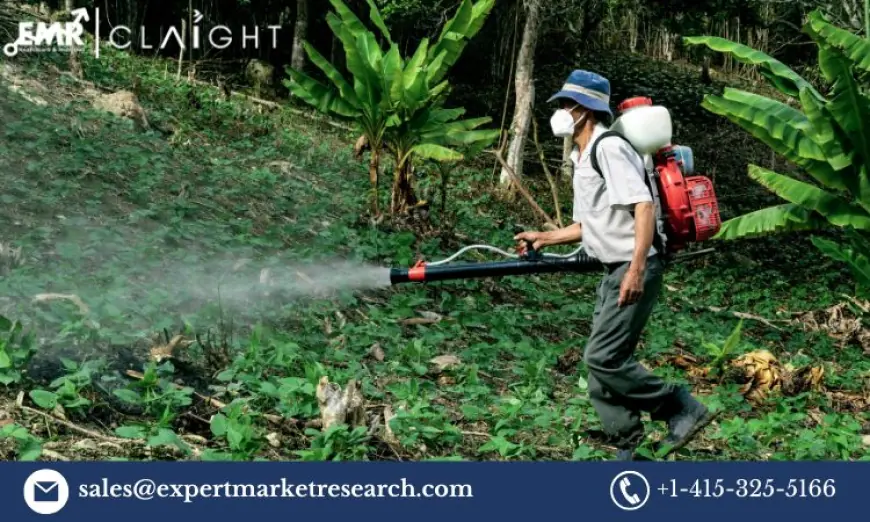Agrochemicals Market: Trends, Growth, Opportunities, and Forecast 2025-2034
The global agrochemicals market plays a critical role in the modern agricultural ecosystem. As the demand for food production continues to rise, driven by a growing global population and changing climate conditions, the need for agrochemicals—such as pesticides, fertilizers, and herbicides—has become increasingly vital to ensure crop yield, quality, and protection. With a market size valued at approximately USD 239.92 billion in 2024

The global agrochemicals market plays a critical role in the modern agricultural ecosystem. As the demand for food production continues to rise, driven by a growing global population and changing climate conditions, the need for agrochemicals—such as pesticides, fertilizers, and herbicides—has become increasingly vital to ensure crop yield, quality, and protection. With a market size valued at approximately USD 239.92 billion in 2024, the global agrochemicals market is projected to grow at a compound annual growth rate (CAGR) of 3.1% between 2025 and 2034. By 2034, it is expected to reach a value of around USD 314.87 billion, reflecting the growing demand for advanced agricultural solutions across the world.
In this article, we will explore the overview of the agrochemicals market, including its size, share, key market dynamics, trends, growth factors, opportunities, challenges, and an analysis of leading competitors. Additionally, we will look at some of the prominent players shaping the future of this essential industry.
Overview of the Agrochemicals Market
Agrochemicals, also known as agricultural chemicals, are chemicals used in farming to enhance crop production and protect crops from pests, diseases, and weeds. The primary categories of agrochemicals include fertilizers, herbicides, insecticides, fungicides, and plant growth regulators. These chemicals help increase food production, improve crop quality, and ensure more efficient use of land and water resources.
The demand for agrochemicals is primarily driven by the increasing global population, which necessitates higher food production. As the population grows, there is greater pressure on agricultural systems to produce more food while managing limited natural resources. This has led to the growing adoption of agrochemical solutions that help farmers maximize crop yield and quality.
Agrochemicals also play a key role in mitigating the impact of various environmental factors, such as pests, diseases, and adverse weather conditions. This, in turn, enhances the resilience of crops, ensuring that global food systems remain sustainable and productive.
Size & Share of the Agrochemicals Market
The global agrochemicals market is currently valued at approximately USD 239.92 billion in 2024. The market's share is divided across various products and regions, with a strong focus on fertilizers, pesticides, and herbicides, which are the primary categories of agrochemicals. The size and share of the market are influenced by factors such as agricultural trends, crop protection needs, and regional demand for food production.
By Product Type:
-
Fertilizers: Fertilizers account for the largest share of the agrochemicals market. The growing demand for high-quality, nutrient-rich crops is driving the need for both synthetic and organic fertilizers. Nitrogen, phosphorous, and potassium-based fertilizers are the most widely used globally, contributing significantly to market growth.
-
Pesticides: The pesticide segment, including insecticides, herbicides, and fungicides, also holds a significant market share. These products are essential in protecting crops from pests, weeds, and fungal infections, and their use continues to rise, especially in regions with large-scale agricultural production.
-
Others: Other agrochemical products, including plant growth regulators and biocontrol agents, also contribute to the overall market. These products are increasingly gaining traction due to their sustainability and environmental benefits.
By Application:
-
Crop Protection: Crop protection applications, such as pesticides and herbicides, account for a large share of the agrochemicals market. They are critical in preventing damage caused by pests, weeds, and diseases, which can drastically reduce agricultural output.
-
Soil Nutrition: The soil nutrition segment includes the use of fertilizers and soil conditioners to improve soil health and enhance nutrient availability to crops, thus ensuring better crop yields.
By Region:
-
North America: North America is one of the largest consumers of agrochemicals, driven by high agricultural production in the United States and Canada. The region's adoption of advanced farming practices, such as precision agriculture, has further boosted the demand for agrochemicals.
-
Europe: Europe also represents a significant share of the market, with strong agricultural sectors in countries like Germany, France, and Italy. European regulations on agrochemicals are stricter, with an increasing focus on sustainability and eco-friendly solutions.
-
Asia-Pacific: The Asia-Pacific region, particularly countries like China and India, is experiencing rapid growth in agrochemical consumption due to the rising demand for food crops, expanding agricultural industries, and government incentives promoting agricultural modernization.
-
Latin America: Latin American countries such as Brazil and Argentina are major consumers of agrochemicals, with the region's vast agricultural land and increasing adoption of modern farming techniques.
Market Dynamics & Trends
Several factors are influencing the agrochemicals market, including demographic shifts, technological advancements, environmental concerns, and evolving regulatory frameworks. Understanding these market dynamics and trends can help stakeholders stay ahead in this competitive landscape.
-
Rising Global Food Demand:As the global population continues to grow, the demand for food has escalated, putting pressure on farmers to increase crop yields. Agrochemicals play a vital role in meeting this demand by enhancing crop productivity and protecting against pests and diseases, driving market growth.
-
Sustainability and Eco-friendly Solutions:The shift toward sustainable farming practices is a significant trend in the agrochemicals market. Farmers are increasingly looking for eco-friendly and less harmful alternatives to traditional agrochemicals. Biocontrol agents, organic fertilizers, and integrated pest management (IPM) systems are gaining popularity as farmers strive to reduce their environmental impact while maintaining high productivity.
-
Technological Advancements:Advancements in agrochemical technologies, such as the development of precision farming tools, drones, and data analytics, are transforming how agrochemicals are applied. These innovations help optimize the use of fertilizers and pesticides, reducing waste and environmental impact while maximizing crop yield.
-
Regulatory and Compliance Issues:Regulations surrounding the use of agrochemicals vary across regions, with stricter rules in Europe compared to other parts of the world. Governments are increasingly focusing on reducing the environmental footprint of agrochemicals by setting regulations on pesticide usage, product formulation, and approval processes. Companies operating in the agrochemicals market must comply with these regulations to stay competitive.
-
Shift Toward Biological and Natural Solutions:There is an increasing shift toward biological and natural alternatives to chemical-based agrochemicals. Biopesticides, biofertilizers, and microbial inoculants are gaining traction as farmers seek sustainable solutions that are less toxic to the environment and non-target organisms.
Get a Free Sample Report with a Table of Contents:
https://www.expertmarketresearch.com/reports/agrochemicals-market/requestsample
Growth of the Agrochemicals Market
The agrochemicals market is expected to experience steady growth during the forecast period, with a projected CAGR of 3.1% from 2025 to 2034. Several factors are contributing to this growth, including the need for increased agricultural output, technological advancements in the farming sector, and the adoption of more sustainable agrochemical products.
-
Adoption of Modern Agricultural Practices: :As farmers continue to adopt modern agricultural practices, including precision farming and digital tools for crop monitoring, the demand for efficient and targeted agrochemical applications is increasing. This shift toward data-driven farming practices is helping optimize the use of agrochemicals, thereby driving market growth.
-
Government Support and Policies: :Governments around the world are promoting the adoption of advanced farming technologies and agrochemical solutions to boost food production. Subsidies and financial support for farmers adopting sustainable agrochemical products are expected to contribute to the market’s growth.
-
Technological Integration in Crop Protection: :The integration of new technologies in crop protection, such as drones, sensors, and autonomous equipment, is transforming the agrochemicals landscape. These innovations are enabling more efficient and precise applications of pesticides, fertilizers, and herbicides, further driving market demand.
-
Market Opportunities and Challenges :While the agrochemicals market presents several growth opportunities, there are also challenges that could hinder its progress. Understanding these factors is essential for businesses operating in the market.
Opportunities:
-
Growth in Emerging Markets: Emerging markets, particularly in Asia-Pacific and Latin America, represent significant growth opportunities for the agrochemicals industry. As agriculture in these regions modernizes and productivity increases, the demand for agrochemical products will rise.
-
Rise in Organic Farming: With the increasing popularity of organic farming, the demand for organic and natural agrochemical products is expected to rise. This shift towards organic farming presents a lucrative opportunity for companies to develop and market eco-friendly alternatives.
-
Collaborations and Partnerships: Strategic collaborations and partnerships between agrochemical manufacturers, agricultural technology firms, and research institutions offer growth opportunities. Such collaborations can help accelerate the development of new products and technologies.
Challenges:
-
Environmental Concerns: Despite the growing adoption of sustainable farming practices, environmental concerns related to the excessive use of agrochemicals remain. Over-reliance on chemical products can lead to soil degradation, water contamination, and loss of biodiversity, which may hinder market growth.
-
Regulatory Hurdles: Stringent regulations surrounding agrochemical products, especially in regions like Europe, pose challenges for manufacturers. The approval processes for new products can be time-consuming and costly, limiting innovation and market entry for new players.
-
Public Perception and Health Concerns: Concerns over the potential health impacts of agrochemical products, including pesticides and fertilizers, continue to affect public perception. This could lead to increased demand for safer, natural alternatives and pressure for more stringent regulations.
Competitor Analysis
The agrochemicals market is highly competitive, with several large players dominating the landscape. These companies are continuously working on innovations, partnerships, and acquisitions to strengthen their market position.
-
The Mosaic Company :The Mosaic Company is a leading global producer of potash and phosphate products, essential fertilizers in the agrochemicals industry. The company’s strong product portfolio and global presence make it a dominant player in the market.
-
Nutrien Ltd. :Nutrien Ltd. is a major supplier of agricultural products, including fertilizers and crop protection solutions. The company has a broad portfolio and a significant market presence, offering a range of sustainable and efficient agrochemical solutions.
-
Nufarm Ltd. :Nufarm Ltd. is an Australian-based company specializing in crop protection products, including herbicides, fungicides, and insecticides. Nufarm's innovative products are used by farmers worldwide to improve crop yield and protect against pests and diseases.
-
Yara International ASA :Yara International ASA is a Norwegian-based company known for its high-quality fertilizers. Yara’s strong focus on sustainability and environmental responsibility has positioned it as a leader in the agrochemicals market, particularly in fertilizers.
-
Others :Other significant players in the agrochemicals market include BASF, Bayer AG, Corteva, Syngenta, and FMC Corporation. These companies lead in product innovation and global distribution, contributing to the continued growth of the agrochemicals market.
Explore our trending Blogs and Reports :
Top Construction Companies
HVAC Variable Frequency Drive Market
What's Your Reaction?
 Like
0
Like
0
 Dislike
0
Dislike
0
 Love
0
Love
0
 Funny
0
Funny
0
 Angry
0
Angry
0
 Sad
0
Sad
0
 Wow
0
Wow
0


















































